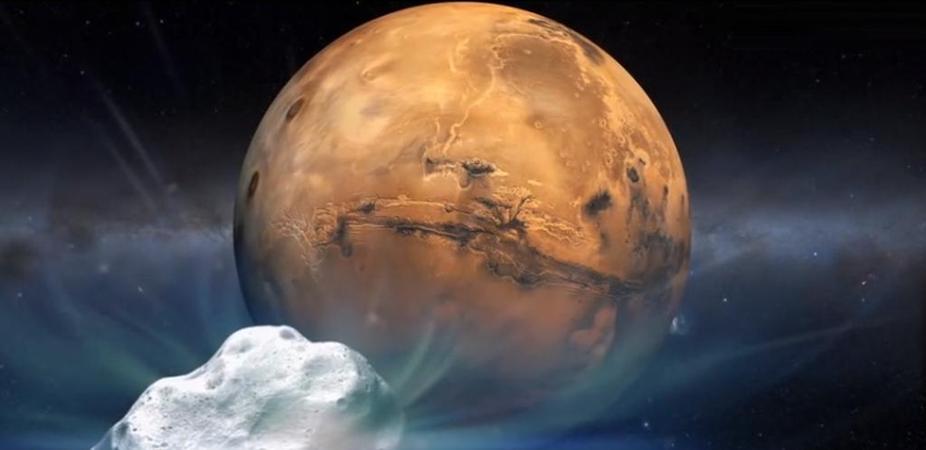Astronomers world-wide are gearing up for what NASA calls a “once in a lifetime“ event: the Comet Siding Spring will swing past Mars on its maiden voyage through the solar system in the early hours next Monday (AEDT), and thanks to a fleet of spacecraft and rovers on and around the Red Planet, we'll have a front row view.
“Space is big, so we don’t really expect a comet to come so close to a planet like Mars or Earth,” Tanya Hill, curator of the Melbourne Planetarium, said.
Michael Brown, an observational astronomer at Monash University, said the passage of Comet Siding Spring – formally known C/2013 A1 – is the closest passage of a comet we’ve ever seen, with the exception of comets that crashed into Jupiter.
“It'll pass closer to Mars than the distance between the Earth and the moon,” he said.
And while NASA alone has 16 instruments waiting to monitor the comet’s flyby, other space agencies and Earth-based telescopes will keep an eye on the comet.
An Aussie Astronomical Find
Comet Siding Spring is a relatively recent discovery. Rob NcNaught, astronomer at the ANU and the Siding Spring Observatory in New South Wales, first spotted the comet on January 3 last year.
Jonti Horner, an astronomer at the University of Southern Queensland, said the comet is probably on its first pass through the solar system since it formed 4.5 billion years ago.
“These [comets] are probably the most pristine leftovers of the formation of the planets [in the solar system] we have. In the case of this comet, it’s been held in cold storage in what’s called the Oort Cloud, a vast reservoir of comets halfway to the nearest star, since the solar system formed,” he said.
“They’re really interesting to look at if you want to find out how the planets were made. Certainly, it’s quite likely the water on the Earth was delivered by comets like this, colliding with the Earth.”
Protecting the Goods
Dr Hill said that with NASA and other space agencies having so many craft circling in orbit around Mars, “it’s a great opportunity for them to try to use their cameras and instruments to get a close-up view of the comet”.
Comet Siding Spring is about to fly historically close to Mars. The encounter could spark Martian auroras, a meteor shower, and other unpredictable effects.
But, said Dr Brown, there’s a catch to this front row seat.
“They have to protect that equipment. The comet will pass Mars at about 50km/s so even a small grain of dust running into spacecraft at that speed is going to do a lot of damage,” he said.
“As the comet’s travelling through the solar system it’s closer to the sun than it normally is, and the heat of the sun is burning off some of the ices and gas that make up the comet. That boiling off of ice and gas is pushing away dust particles which are travelling with the comet at more than 50km/s, and it’s those particles the spacecraft need to be protected from.”
In fact, the comet is shedding 100kg of dust per second, so NASA has prepared – and in some cases moved – its orbiting spacecraft to reduce the chance of damage.
Comet Siding Spring isn’t the first to be photographed by spacecraft in our solar system.
“There was a European spacecraft [the Giotto probe] that was sent to Halley’s comet back in the 1980s and it got very close to the comet and took some awesome pictures but it did get a knockout punch by one or two pieces of comet dust,” Dr Brown said.
“There is historical precedent for spacecraft getting damaged by comet dust, but admittedly that spacecraft was heading almost right towards the comet.”
So Can We See It?
Viewing the comet and Mars at the same time would be a unique thing to see, and while initial reports claimed that amateur astronomers would be able to see the action using a small telescope or even binoculars, it’s unlikely their equipment will be able to pick up the comet.
“It’s a very small comet – the snowball in the middle is just 400m wide – so from Earth it’s very unimpressive,” Dr Horner said.
“It’s a lot fainter than what was expected,” Dr Hill said. “I'll be checking in on Twitter and online, that’s for sure.”
You can follow the comet on NASA’s Comet Siding Spring page.
Belinda Smith is a Science and Technology Editor at The Conversation. This article was originally published on The Conversation. Read the original article.
